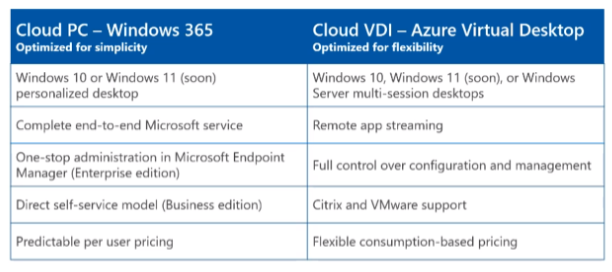Azure Virtual Desktop Versus Windows 365: Which Desktop-as-a-Service is best for your organization?
Azure Virtual Desktop (AVD) and Windows 365 enable organizations to take advantage of Desktop-as-a-Service (DaaS) for end-users.
These are similar solutions but optimized for different use cases. Navigating them can be complex - save money by licensing appropriately for your specific needs!
Similarities of Azure Virtual Desktop and Windows 365:
AVD and Windows 365 share a common ground in functionality and use cases. Both solutions provide remote desktops to users. They are used to empower remote workers with powerful desktops from anywhere. These solutions remain secure because the end-user unmanaged hardware (pc, tablet, phone) is separate from the processing power of the virtual desktops provided to run the user’s applications.
Zero Trust is a security strategy based on the principles of “never trust, always verify.” Zero trust principles are followed for both solutions to provide secure remote work for end-users. Recommended security policies include enforcement of strong user authentication (MFA) and virtual desktop health checks before allowing access. However, malicious actors and threats are more advanced than ever – and local device and perimeter firewalls no longer provide sufficient protection. Windows 365 and Azure Virtual Desktop are deployed into a segmented, secured Azure virtual network and deliver to users only needed data and apps – thus, minimize risks in the rare case of breach or hardware corruption.
Which Solution is Best for Your Organization?
Understanding which solution is best for your organization between AVD and Windows 365 can be confusing. They look similar and provide similar functionality but ultimately are optimized for different use cases. For example, Azure Virtual Desktop can deploy an application or a desktop, whereas Windows 365 can only deploy a desktop. Some scenarios may be optimized by utilizing both solutions. Here are the main benefits for each:

Windows 365: Optimized for Simplicity
Windows 365 is a complete SaaS solution that securely streams your personalized experience to any device. This means it brings a personalized Windows 10 desktop experience, easy management and deployment, and predictable per-user-per-month costs. Windows 365 is ideal for small businesses that need to rapidly deploy desktops in a simplified manner. The Windows 365 deployment model does not support multi-session desktops or application streaming. End users each use a dedicated single-session VM.
For example, Windows 365 is best for seasonal workforce users since it is optimized for deployment speed and a consistent spend per month that only applies during the work season. If you need strong horsepower or have a seasonal or temporary workforce – Windows 365 may be best for your organization. The subscription cost covers deployment, license, and backend compute. Reserved instances, auto-scaling, and tuning user density on a multi-session host are cost optimization techniques available only to AVD that do not apply well to a seasonal burst workforce making Windows 365 a better fit.
Windows 365 is licensed per-user by Cloud PC SKU. Different SKUs have different sizes and associated performance. Please note, Windows 365 requires Active Directory and Hybrid Azure AD join to function. If your organization needs help setting up the proper infrastructure, Interlink can help.
- Users with Windows Pro endpoints: Windows E3 + EMS E3 or Microsoft 365 F3,E3,E5,Business Premium.
- Users with non-Windows Pro endpoints: Windows VDA (Virtual Desktop Access) E3 + EMS E3 or Microsoft 365 F3/E3/F5/Business Premium.
Azure Virtual Desktop: Optimized for Flexibility
Azure Virtual Desktop is a flexible Cloud VDI platform that securely delivers streaming apps or a personalized Windows 10 desktop experience from single-session and multi-session AVD hosts. AVD offers full control over management and deployment with options for Citrix and VMware integrations. Pricing is more flexible with software licenses and Azure resource consumption priced separately. AVD can be highly cost-optimized through 1- or 3-year Azure compute and storage reserved instances, auto-scaling, scheduled session host stop/start, and utilizing multi-session hosts over single-session hosts for delivering apps and desktops.
For example, AVD is best used for groups of users that have similar needs and tools. If your organization needs to deploy a number of desktops for a department while maintaining control over security and the management – AVD may be right for you. These users will share a VM and utilize the same desktop image. Suppose your organization needs to deploy a consistent experience for your full-time accounting department employees – while consumption-based. In that case, AVD can take advantage of reserved instances and user density tuned multi-session hosts to minimize spending.
- The AVD Platform-as-a-Service can be set up to stream apps or full desktops as Software-as-a-Service to external users (Azure AD guest accounts). Windows 365 Cloud PC only supports internal users (School or Work, Azure AD member accounts).
- AVD is priced based on an organization's license plus Azure consumption.
- Users accessing Win10 host: Windows E3, E5, A3, A5
- Users accessing Win10 + Office 365 host: Microsoft 365 E3, E5, A3, A5, F3, Business Premium
How Interlink Can help:
Understanding which solution is best for your specific environment is complicated and requires careful consideration of several factors. Contact Interlink today if your organization needs guidance or licensing expertise for your specific environment.
Steven Braunschweiger
Steven Braunschweiger is a Senior Enterprise Architect at Interlink. Steven is a talented IT Architect and Technical Leader for over 20 years and has assisted companies in transforming their Hybrid Cloud Solutions. With multiple certifications in Azure Solutions, Steven is a key member of the Interlink team, here providing technical expertise to clients, and in helping our team implement and driving ongoing best practice development in our service delivery.


